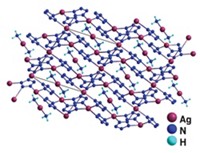Advertisement
Grab your lab coat. Let's get started
Welcome!
Welcome!
Create an account below to get 6 C&EN articles per month, receive newsletters and more - all free.
It seems this is your first time logging in online. Please enter the following information to continue.
As an ACS member you automatically get access to this site. All we need is few more details to create your reading experience.
Not you? Sign in with a different account.
Not you? Sign in with a different account.
ERROR 1
ERROR 1
ERROR 2
ERROR 2
ERROR 2
ERROR 2
ERROR 2
Password and Confirm password must match.
If you have an ACS member number, please enter it here so we can link this account to your membership. (optional)
ERROR 2
ACS values your privacy. By submitting your information, you are gaining access to C&EN and subscribing to our weekly newsletter. We use the information you provide to make your reading experience better, and we will never sell your data to third party members.
Environment
Sulfate Extractor
Macrocycle excels at removing sulfate anion from nitrate-rich aqueous solutions
by Ron Dagani
August 22, 2007

A small amount of corrosion-inducing sulfate anion in nuclear waste can make long-term storage difficult, so chemists have long been seeking a molecule that could selectively remove the sulfate. Now they have found the first promising candidate for a sulfate anion extractant: a doughnut-shaped molecule consisting of eight pyrrole units, each of which bears an 11-carbon alkyl chain to make the molecule more soluble in organic solvents.
This so-called cyclo[8]pyrrole has a central cavity that is just the right size for binding to sulfate anion, according to Jonathan L. Sessler of the University of Texas, Austin. His team synthesized and studied the porphyrin-like compound in collaboration with Bruce A. Moyer of Oak Ridge National Laboratory. They have found that a toluene solution of the cyclo[8]pyrrole can extract sulfate anion out of aqueous solutions that are much richer in nitrate anion???the situation found in radioactive waste.
Nitrate, which is less charged and less hydrated than sulfate, is normally easier to extract into the organic phase, Sessler and Moyer explained. But the cyclo[8]pyrrole reverses this bias, preferring to tightly bind sulfate within its cavity and chaperone it into the organic phase. To make the sulfate extraction occur at a reasonable rate, the researchers added a commercially available phase-transfer catalyst to the organic phase.
Moyer and Sessler presented their findings in a Division of Inorganic Chemistry symposium at this week's ACS national meeting in Boston. By happenstance, their findings also were published this week in the Journal of the American Chemical Society (DOI: 10.1021/ja074568k). Reviewers of the paper hailed the results as "highly convincing" and "a breakthrough in selective sulfate extraction."
The impetus for finding a sulfate extractant arose from the proposal to dispose of nuclear waste by incorporating it into transportable borosilicate glass "logs" that would be stored for millennia in a geologic repository. Sulfate, it turns out, is so poorly soluble in borosilicate glass that it would lead to corrosion and other equipment problems and would compromise the integrity of the glass logs, Moyer told C&EN.
Because there was no good way to remove low levels of sulfate from nuclear waste, the Department of Energy has also been considering alternatives, such as reformulating the glass so that sulfate would be more soluble in it, Moyer said. Nevertheless, a practical way to remove the sulfate could reopen a useful option.
In Moyer's view, the most significant aspect of this discovery is that it demonstrates that if a host molecule is "preorganized"—that is, it doesn't have to rearrange to bind a guest—it can do a great job of binding an anion that fits in the cavity.
Although the cyclo[8]pyrrole works reasonably well, it is not yet a practical sulfate extractant for nuclear waste, according to Sessler and Moyer. They are working to improve its speed and selectivity by tweaking the molecule synthetically, such as adjusting the size of the doughnut hole.
"The key point is that we've gotten off the ground," Sessler said. "And in science, that's really critical."





Join the conversation
Contact the reporter
Submit a Letter to the Editor for publication
Engage with us on Twitter